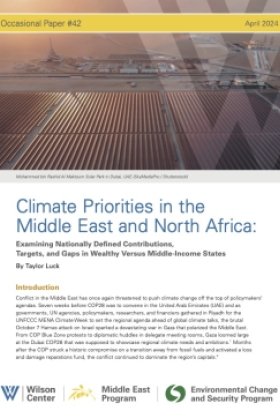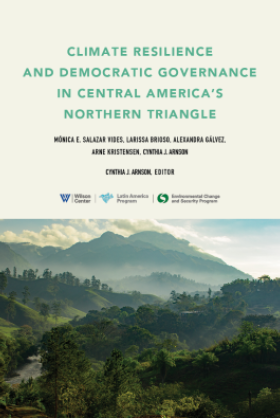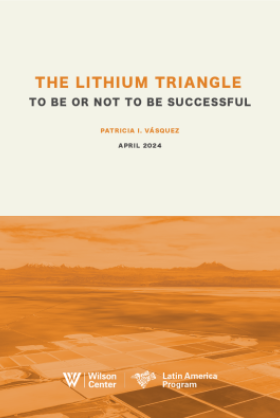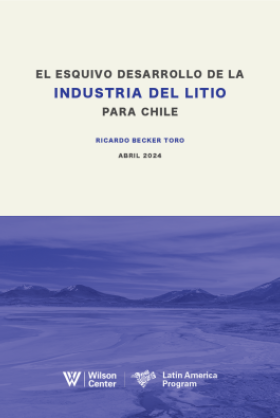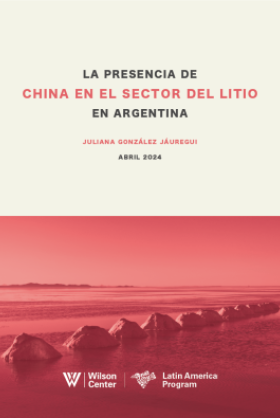Strengthening Responses to Climate Variability in South Asia
Climate change and conflict can create a self-reinforcing feedback loop: Climate change exacerbates existing conflicts, while conflict makes adapting to climate change more difficult, said Janani Vivekananda of International Alert at the Wilson Center on February 7. She presented the results of nine case studies conducted in India, Pakistan, Bangladesh, and Nepal to find how communities are affected by and adapting to climate change in conflict-prone settings.
Overview
Climate change and conflict can create a self-reinforcing feedback loop: Climate change exacerbates existing conflicts, while conflict makes adapting to climate change more difficult, said Janani Vivekananda of International Alert at the Wilson Center on February 7.
She presented the results of nine case studies conducted in India, Pakistan, Bangladesh, and Nepal to find how communities are affected by and adapting to climate change in conflict-prone settings.
Vivekananda said that although the relationship between climate change and conflict has gained much attention recently, “broad brush” research doesn’t capture the nuances that International Alert’s partners saw on the ground in South Asia.
Reflecting Granularity, Recognizing Commonalities
“These kinds of issues aren’t generalizable at the national level,” Vivekananda said. Political systems or even microclimates can distinguish one community from another. “You do need to understand this granularity if you want to ensure the impact of the policies you’re trying to implement, namely effective adaptation that’s targeted at the most marginalized and vulnerable communities in affected countries.”
“I think it’s extremely helpful to have this type of study that has a much finer resolution,” said David Michel, director of environmental security at the Stimson Center. Smaller-scale case studies can help tease out complexities and variability at the local level, he said. And sensitivity to the distinct situations of each community is important for policymakers, “because getting it wrong will have a disproportionate impact on peace and security in these contexts.”
The case studies took place in very diverse contexts. Some were urban communities, some mountainous, some coastal. But Vivekananda noted that “there were a surprising number of really strong threads” across all four countries.
For example, many of the communities face compound risks. The community members most vulnerable to climate change are also those least able to adapt to it. Vivekananda described how poorer tenant farmers were less able to adopt climate resistant crops and farming techniques than wealthier landowners, for instance. And a doctor’s job is less dependent on the rainy season than a farmer’s.
Along these lines, education “isn’t something that would necessarily be seen as a climate adaptation strategy,” but it can make a big difference, Vivekananda said. Better access to and quality of education increases “the chances of the next generation not having to pursue highly climate sensitive agricultural livelihoods,” the report authors wrote.
Migration a Double-Edged Sword
According to Vivekananda, migration was found in all the areas studied but has been “ignored in all climate change and development plans.”
For some communities, like those in Nepal, migration is viewed positively and community members rely heavily on remittances. For others, like in Bangladesh, the impact on families and societies can sometimes outweigh the financial benefits. But in all cases, migration is seen as a “significant adaptive strategy” and Vivekenanda argued that it’s one that should be better understood and managed in adaptation plans.
Michel agreed that it’s crucial to examine migration, but suggested that this complex issue is not always a positive adaptive strategy. In Nepal, for example, migration can be positive for communities experiencing climate stress, but negative for the cities they move to, like Kathmandu, which are often unprepared for the influx of people. “The pollution is awful, the water quality is terrible, there are huge pressures on the infrastructure,” he said.
Additionally, climate change in the region is leading to greater water scarcity and degradation in some places, and migration that was once acceptable can now lead to conflict as pastoralists compete for grazing land with agriculturalists. Michel highlighted one such example from the Pakistan case study where people from the Thar desert have been barred from their traditional seasonal migration to nearby Badin by local residents due to declining vegetation cover.
Integration a Realistic Imperative?
“If there’s one issue that ties climate change and conflict together in South Asia, it’s water,” said senior advisor for natural resource management at USAID’s Asia and Middle East Bureaus, Mary Melnyk. It is “fundamental to some of the existing tensions” in many conflict-affected communities and could alsocontribute to future tensions, she said. Changing weather patterns mean less rainfall; retreating glaciers and snowpack are already decreasing downstream flows; and monsoons are less predictable. At the same time, demand for water is growing because of increases in population and water use, particularly by industry in the region.
USAID is looking to address these issues with an “integrated approach that recognizes this dynamic”. Melynk highlighted how USAID’s water security efforts increase food security, decrease susceptibility to extreme weather events, and reduce tensions that can result from competition over water.
“We also recognize, not only is [water management] complex, but we also have scarce resources,” Melnyk continued. “We’re looking for multiple benefits in our interventions.”
“‘Integrated’ water resources management is the way to go,” agreed Michel. “Who would be for ‘fragmented’ and ‘ad hoc’ water resources management?” But “integration is probably working better as an incantation than it is in implementation,” he continued. “If you want to move on from the verbiage of ‘integrated water resources management,’ you have to ask, ‘well, what’s being integrated? How many sectors are we talking about? Who are the stakeholders?’”
Where there are competing interests, choices have to be made. “That’s where it’s so important to identify the granularity, the complexity, the local implications. Because we have to be aware of what interests are being favored in the power relationships that may exist within these decision-making structures.”
Preparing for Known Unknowns
Part of the challenge in planning for climate change adaptation is the lack of available data in South Asia. Michel pointed out that the inhospitable landscape of the region makes it difficult to gather information. “There are more weather stations in Switzerland than the entire Tibetan Plateau which is 60 times its size,” he said to illustrate his point. “How are we going to adapt, how are we going to build resilience if we don’t even know what we’re building resiliency to?”
While the panelists agreed there was a need for better information about how exactly the environment is changing, they also pointed out that there are many aspects of climate change that are, by their nature, unpredictable, and adaptation plans should reflect this uncertainty.
The case studies offered a few general recommendations for improving resilience, including considering planned migration as a valid option, encouraging private sector involvement in alternative livelihoods creation, and improving access to quality education to allow community members to be less dependent on climate-sensitive livelihoods like farming and fishing.
“Building resilience should help address the root causes of vulnerability, creating increased capacity to be able to adapt to a range of possible climate futures,” said Vivekananda. If adaptation efforts are too narrowly focused on “specific climate impacts” and “they don’t play out, in a fragile context that could be quite destabilizing and seen as a wasted opportunity.”
“We want to make our systems not only resilient,” Michel said, “but robust to change.”
Case studies for India, Pakistan, and Nepal, and an executive summary of the research can be found on International Alert's website.
Drafted by Carolyn Lamere, edited by Schuyler Null
Speakers
Mary Melnyk
David Michel
Janani Vivekananda
Hosted By

Environmental Change and Security Program
The Environmental Change and Security Program (ECSP) explores the connections between environmental change, health, and population dynamics and their links to conflict, human insecurity, and foreign policy. Read more

Indo-Pacific Program
The Indo-Pacific Program promotes policy debate and intellectual discussions on US interests in the Asia-Pacific as well as political, economic, security, and social issues relating to the world’s most populous and economically dynamic region. Read more

Global Risk and Resilience Program
The Global Risk and Resilience Program (GRRP) seeks to support the development of inclusive, resilient networks in local communities facing global change. By providing a platform for sharing lessons, mapping knowledge, and linking people and ideas, GRRP and its affiliated programs empower policymakers, practitioners, and community members to participate in the global dialogue on sustainability and resilience. Empowered communities are better able to develop flexible, diverse, and equitable networks of resilience that can improve their health, preserve their natural resources, and build peace between people in a changing world. Read more
Thank you for your interest in this event. Please send any feedback or questions to our Events staff.
